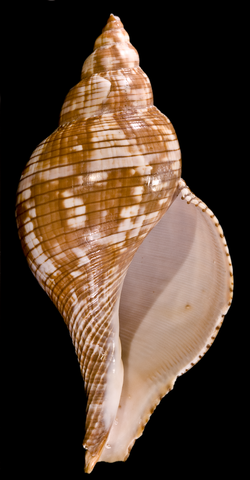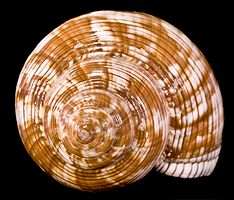Fasciolaria Tulipa
- Fasciolaria Tulipa
-
Fasciolaria tulipa
L'espèce Fasciolaria tulipa est un mollusque marin appartenant à la famille des Fasciolariidae,les escargots de mer prédateurs, subtropicaux et tropicaux de l'océan Atlantique Ouest.
Répartition
Cette espèce se rencontre depuis la côte de la Caroline du Nord tout au sud et l'ouest jusqu'à la côte du golfe du Mexique, également dans les Antilles.
Description
Le mot «tulipe», décrit la forme générale de la coquille de ces espèces, qui ressemble à une fleur de tulipe fermée. On peut compter jusqu'à 9 spires. La surface est lisse, à l'exception de très fines lignes de croissance. L'opercule est épais, et lourd. La coquille est blanchâtre à brune, avec des rangées de taches brun foncé de tailles diverses; en plus des taches il existe fines lignes qui courrent le long des spires de la coquille. L'animal vivant est orange vif.
- Longueur pour un adulte : de 6.4 à 24.1 cm.
Habitus
Cette espèce vit habituellement dans le sable ou la boue à une profondeur d'environ 10 métres. Elle est molluscivore: cet escargot se nourrit de bivalves et de gastéropodes divers, y compris individu de sa propre espèce.
Galerie
 |
Cliquez sur une vignette pour l’agrandir |
Notes et références
- Wikipedia (en)
- Arianna Fulvo et Roberto Nistri (2005). 350 coquillages du monde entier. Delachaux et Niestlé (Paris) : 256 p. (ISBN 2-603-01374-2)
 Portail de la zoologie
Portail de la zoologie
Catégories : Mollusque (nom scientifique) | Gastéropode
Wikimedia Foundation.
2010.
Contenu soumis à la licence CC-BY-SA. Source : Article Fasciolaria Tulipa de Wikipédia en français (auteurs)
Regardez d'autres dictionnaires:
Fasciolaria tulipa — A live Fasciolaria tulipa out of water Scientific classification Kingdom: Ani … Wikipedia
Fasciolaria tulipa — Fasciolaria tulipa … Wikipédia en Français
Fasciolaria tulipa — Fasciolaria tulipa … Wikipédia en Français
Fasciolaria tulipa — Tulip shell Tu lip shell , n. (Zo[ o]l.) A large, handsomely colored, marine univalve shell ({Fasciolaria tulipa}) native of the Southern United States. The name is sometimes applied also to other species of {Fasciolaria}. [1913 Webster] … The Collaborative International Dictionary of English
Fasciolaria lilium — Abapertural view of a shell of Fasciolaria lilium Scientific classification Kingdom: Animalia … Wikipedia
Fasciolaria — Tulip shell, Fasciolaria Apertural view of the shell of a Fasciolaria tulipa. Scientific classification Kingdom … Wikipedia
Fasciolaria — Tulip shell Tu lip shell , n. (Zo[ o]l.) A large, handsomely colored, marine univalve shell ({Fasciolaria tulipa}) native of the Southern United States. The name is sometimes applied also to other species of {Fasciolaria}. [1913 Webster] … The Collaborative International Dictionary of English
Tulip shell — Taxobox name = Tulip shell, Fasciolaria sp. image width = 130px regnum = Animalia phylum = Mollusca classis = Gastropoda subclassis = Orthogastropoda ordo = Sorbeoconcha subordo = Hypsogastropoda infraordo = Neogastropoda familia = Fasciolariidae … Wikipedia
РАКОВИНЫ — твердые покровы тела некоторых животных, например улиток, двустворок или усоногих рачков. Наибольший интерес, особенно с точки зрения практического использования и коллекционирования, представляют известковые раковины моллюсков. Для защиты своего … Энциклопедия Кольера
Murex — For the historical iron industry company, see Murex (company). Murex Apertural view of the shell of Venus Comb Murex, Murex pecten, anterior end towards the bottom of the page Sc … Wikipedia




